

We may earn revenue from the products available on this page and participate in affiliate programs. Learn More ›
Home Advice You Can Trust
Tips, tricks & ideas for a better home and yard, delivered to your inbox daily.
By signing up you agree to our Terms of Service and Privacy Policy.
For the Yardwork-Averse

Some plants that appear stunning at the nursery turn out to be high maintenance once you get them home. It can take a lot of work to keep a plant looking its best, especially in the fall when there are many other chores to tackle. If you’d like to limit your fall tasks to leaf raking, check out this selection of plants that keep their looks as summer transitions into fall and don’t require much effort from you. With a little planning, you’ll be able to spend more time enjoying the seasonal color of these fall plants and less time hunched over in the garden.
Sweet Woodruff

This perennial creeper forms a dense mat of dark green leaves topped with clusters of star-shaped white flowers. Sweet woodruff is a rabbit- and deer-resistant ground cover that thrives in Zones 4 through 8 in part to full shade. Given perfect growing conditions, it can be an aggressive spreader, but it can be easily managed with a lawn mower on a high setting. Available from Etsy
.
Calamint

A good front-of-the-border perennial, calamint is a pollinator magnet that blooms in full sun in the summer and will continue to grow well into fall in Zones 5 through 7. Its pale green leaves are fragrant, and its flowers are diminutive but profuse—and require no deadheading. Available from Etsy
.
North Pole Arborvitae

An excellent choice for the small-space garden in Zones 3 through 7, North Pole arborvitae is a winter-burn-resistant evergreen that can be planted in multiples to form a living privacy fence, or singly as a specimen. Site it in full or partial sun, then watch it grow—it can reach up to five feet wide and 15 feet tall. Available from The Home Depot
.
Panicle Hydrangea
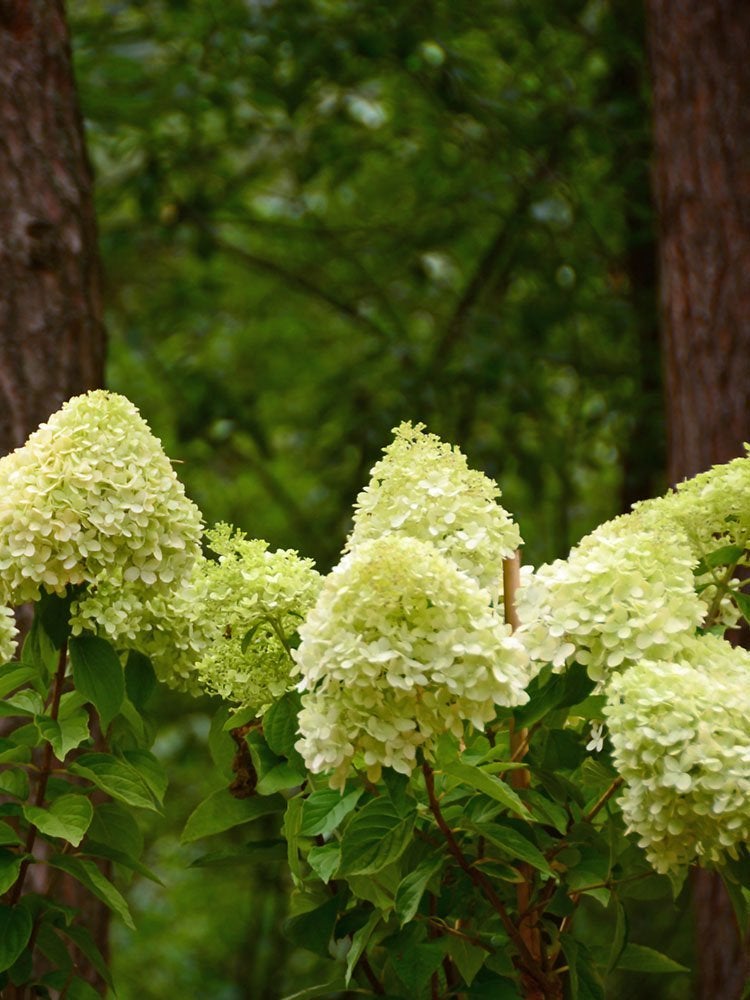
Panicle hydrangea is an enduring deciduous shrub, and there’s a cultivar that’s perfect for every size garden. Plant these stunners in full to partial sun in Zones 3 through 8 and they will reward you with large cone-shaped flowers that emerge white from new wood in July, then transition to various shades of green, pink, and red, depending on the cultivar. Dried blooms provide winter interest if left intact. Available from Etsy
.
Japanese Forest Grass

Available in several variegated leaf types, Japanese forest grass thrives in moist, partly shaded sites and requires little care. The cascading growth habit is particularly attractive planted along the edge of a garden. The plant will spread on its own; to speed the process you may choose to divide the plant in the fall. Cut back spent growth in the winter and let nature do the rest. Available from The Home Depot
.
Rugosa Rose

Do you love the smell of roses but hate their reputation for being high maintenance? Then the rugosa rose may be the perfect rose for you, provided you live in Zones 2 through 7 and away from coastal regions where the plant has been deemed invasive. Rugosa roses have toothy leaves and highly fragrant clove-scented flowers. Deadheading after early August will encourage rebloom, but this will come at the expense of the large, tomato-like rose hips that swell and change color in the fall, and provide a touch of cold-weather visual interest. Available from Etsy
.
Heuchera ‘Caramel’

Beautiful when planted as a border or ground cover in Zones 4 through 8, the unusual golden-apricot leaves (with amethyst-toned undersides) bring unique color to the landscape. Tiny flowers appear on long stems above the mounded foliage in early summer. Removing spent flower spikes will encourage frequent blooming, but when autumn arrives simply sit back and enjoy the fall color. If you live in a particularly cold region, cut back dead growth in late fall and apply a generous layer of mulch around the base of the plant. Available from Etsy
.
Black Lace Elderberry

Lacy, nearly black foliage is the hallmark of this sensational deciduous shrub. Clusters of soft pink flowers provide striking contrast to the dark leaves in summer, then give way to black berries in fall in Zones 4 through 7. Black lace elderberry offers an excellent alternative to Japanese maples and prefers full sun and consistent moisture. Available on Amazon
.
Variegated Solomon’s Seal

Arching green stems of white-edged leaves form colonies in moist shade gardens in Zones 3 through 8, although the plant will also tolerate dry shade conditions. White bell-shaped flowers hang from stems in the spring, and golden fall color makes the plant a stunner late in the year. Available from Etsy
.
Allium ‘Millenium’

This clump-forming member of the onion family sends up strappy green leaves in the spring in Zones 5 through 8. By midsummer, scapes topped with two-inch spherical flower clusters emerge and become pollinator beacons. Flowers can be left on in dried form to provide winter interest. Available from Etsy
.
Aralia ‘Sun King’

Planted in dappled sun, the chartreuse-colored leaves of aralia are certified showstoppers in Zones 4 through 8. The large clump-forming perennial is best placed at the back of a border to allow room for the two-foot-long spikes of pollinator-friendly flowers that appear in summer. Purple berries develop in the fall, and although humans can’t eat them, they’re a favorite of birds. Available from Etsy.
Rhododendron

An alternative to traditional conifers, rhododendrons remain green through the winter in Zones 4 through 8 and thrive in shade or partial shade provided they’re planted in well-draining acidic soils. In April, pink, white, or lavender flower clusters appear on the shrubs, which can reach up to six feet tall. Available from The Home Depot.
Oakleaf Hydrangea

Come autumn, this deciduous shrub is gearing up for quite a show. Its ruby-red leaves shimmer in the landscape, and if left intact, its dried flowers add winter interest in Zones 5 through 9. Because this hydrangea blooms on old wood, there’s no need to cut it back in the fall. In fact, doing so will remove the flower buds for next year. Simply kick back and enjoy the fall display. Available from Etsy
.
Azalea

Depending on the cultivar, azaleas can be evergreen or deciduous, and they’re staples in springtime landscapes across the South. They don’t do well in heavy clay and alkaline soil, so be sure to site in well-balanced, well-draining soil in Zones 4 through 9. Aim for morning sun as most azaleas experience sun scald when overexposed. Available from The Home Depot
.
Strongbox Inkberry Holly

Looking for an alternative to boxwood? This native evergreen resists disease and winter burn, making it perfect for gardeners who want beautiful results with minimal effort. At two to three feet tall and equally as wide, Strongbox has a fast-growing mounded habit that can be pruned or shaped to suit your desired look. For best results, plant in partial to full sun in Zones 5 through 9. Available from Nature Hills
.
Brunnera ‘Jack Frost’
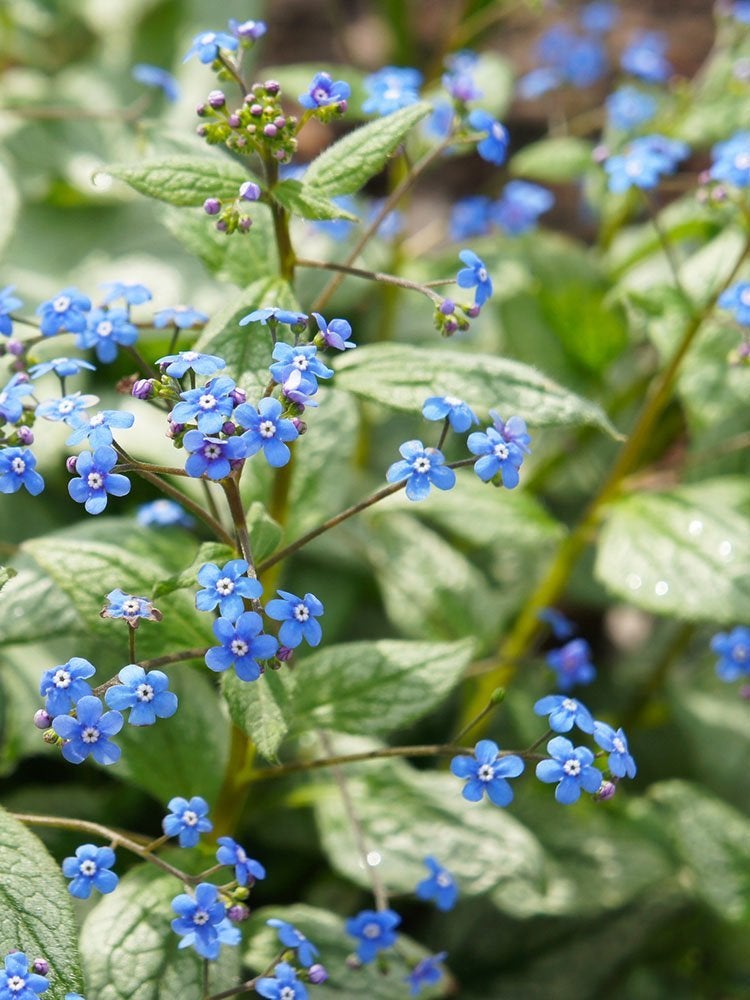
Silver-frosted heart-shaped leaves glisten at the front of the shade border in Zones 3 through 8. Bright blue flowers appear on long scapes that sway above the basal foliage in spring, and the mounding habit remains tidy throughout the growing season. Available from Etsy
.
Sedum

From ground covers to upright forms, there’s a sedum for every sunny situation in Zones 3 through 10. Plants have thick, fleshy foliage and clusters of star-shaped flowers that are pollinator magnets. Flowers typically change color as the season progresses and can be left standing for winter interest. Available from Etsy.
Itea ‘Little Henry’

A diminutive deciduous shrub, Little Henry is an adaptable perennial capable of adjusting to full sun or heavy shade, although fall colors of red, gold, and orange will be less pronounced in shadier conditions. Tiny, fragrant white flowers emerge on long racemes in late spring and early summer. Available from Etsy.
Densiformis Yew

flickr via F.D. Richards
Planted in full sun to part shade in Zones 4 through 7, Densiformis yew is a perfect evergreen shrub for screens or hedges. It takes shearing well and is widely adaptable to most planting situations, with the exception of wet conditions. Available from The Home Depot
.
Ivory Halo Dogwood

Compact, variegated leaves and bright red winter branches are hallmarks of this deciduous shrub. Ivory halo is fast growing and prefers partial to full sun and well-drained soil in Zones 3 through 7. While fall pruning isn’t necessary, removing 25 percent of the oldest stems in early spring will ensure consistently red branches. Available from The Home Depot
.
Variegated Iris

Variegated iris performs best in full sun to part shade in moist conditions in Zones 4 through 9. Vertical lance-shaped leaves emerge in spring, followed by bearded lavender flowers that are sweetly fragrant. Plant near a window or doorway where it can be enjoyed. Available from The Home Depot
.
Prairie Dropseed
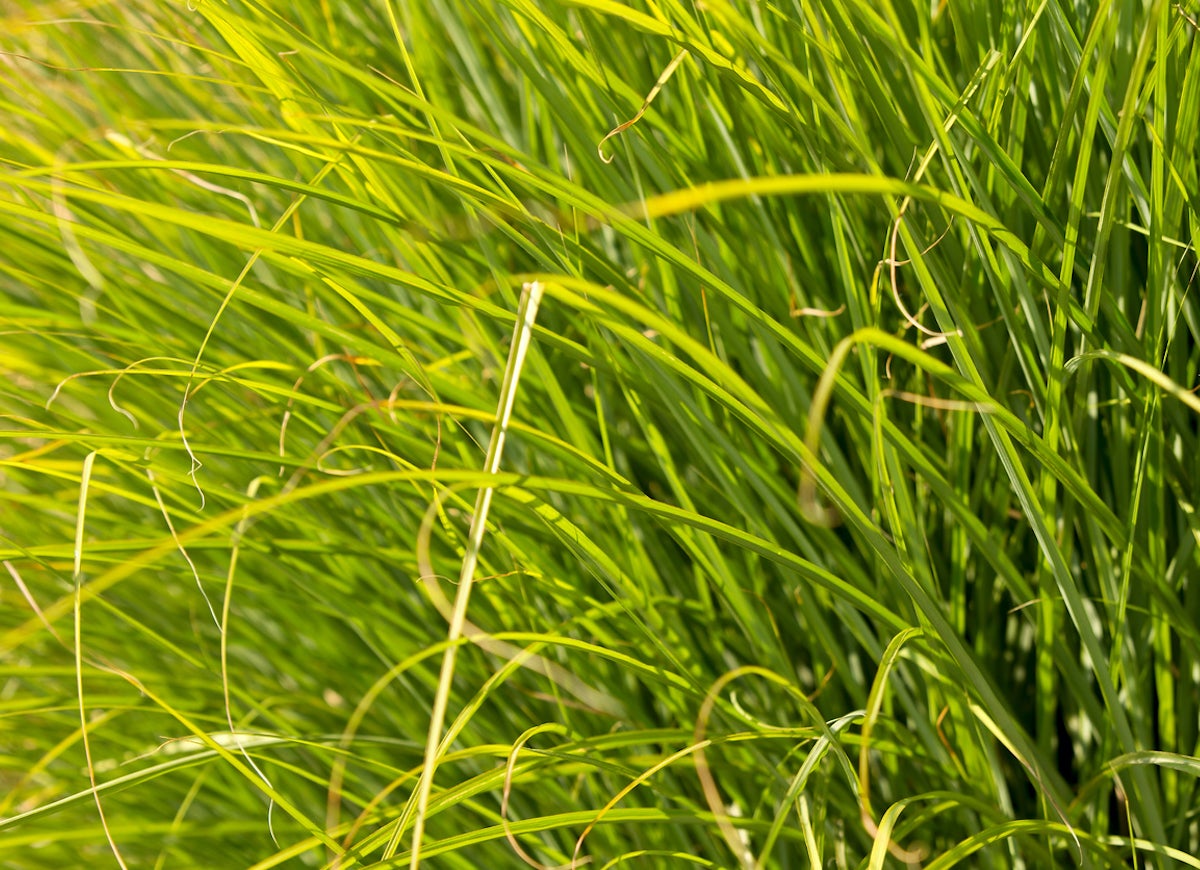
A clump-forming warm-season ornamental grass, prairie dropseed thrives in sunny, dry conditions and tolerates heavy clay soils in Zones 3 through 9. In late summer, flower plumes emerge in shades of pink and brown, and foliage turns orange and gold. Don’t cut back grasses until late winter or early spring as the mound, when dusted with snow, offers winter interest. Available from Etsy
.
Serviceberry ‘Autumn Brilliance’

White flowers that pop in April, edible berries that birds can’t resist, and striking orange and red fall color… Autumn Brilliance serviceberry has it all. It prefers moist, well-drained soil in full sun in Zones 4 through 9 but is widely adaptable, disease resistant, and tolerant of many growing conditions. Available from Etsy
.
Ajuga
Ajuga, a mat-forming ground cover, is an excellent weed suppressant that generates lovely blue flower spikes in the spring. Compact plants form tight clumps of glossy leaves available in a range of colorations, from almost black to variegated combinations of pink, green, and white. The versatile plant will survive with little more than water in Zones 3 through 9 in full sun to partial shade. Available from Etsy
.
Euonymus ‘Emerald Gaiety’

A broadleaf evergreen shrub, Emerald Gaiety sports deep green leaves with creamy white margins that turn pink in the winter in Zones 5 through 8. Plant it near a fence or trellis where it will climb and provide vertical interest. The plant prefers full sun but will tolerate shadier sites. Avoid siting it in wet conditions or in poor-draining soil. Available from The Home Depot
.
Blue Holly

If you want to see the showy red fruits for which this evergreen shrub is known, you’ll need to plant both the male (Blue Prince) and female (Blue Princess) plants to allow for pollination. While hardy in Zones 5 through 7, blue holly stands a better chance of survival if planted in a sheltered site and given winter protection. Available on Amazon
.
Sea Holly ‘Sapphire Blue’

Hot sun and thin soil are all this perennial needs. Flowers, stems, and leaves have blue coloration, and every part of the plant is coarse and thistle-like. Once established, plants don’t transplant well, so site them carefully when you bring them into your landscaping in Zones 5 through 9. The flowers lend a striking look to fresh or dried arrangements. Available from Breck’s.
Beautyberry

While the flowers that appear in spring are insignificant, the fall fruit of the deciduous beautyberry bush is spectacular. Bright purple drupes wrap branches and remain intact well into fall, often holding on until harsh winter weather arrives. Beautyberry, which does best in Zones 6 through 10, shines when many garden plants begin to fade, and the bright berries provide seasonal sustenance for cardinals, blue jays, robins, mockingbirds, woodpeckers, and other backyard birds. Available from The Home Depot
.
Pennsylvania Sedge
Do you need an alternative to turf grass in dry, shady locations? Sedge, native to North America, is a perfect solution as it thrives beneath trees and tall perennial plantings in Zones 3 through 8. The eight-inch-tall plants colonize, forming a dense mat of wispy semi-evergreen leaves that never require mowing. Available from Etsy
.
Lamb’s Ear ‘Helen von Stein’
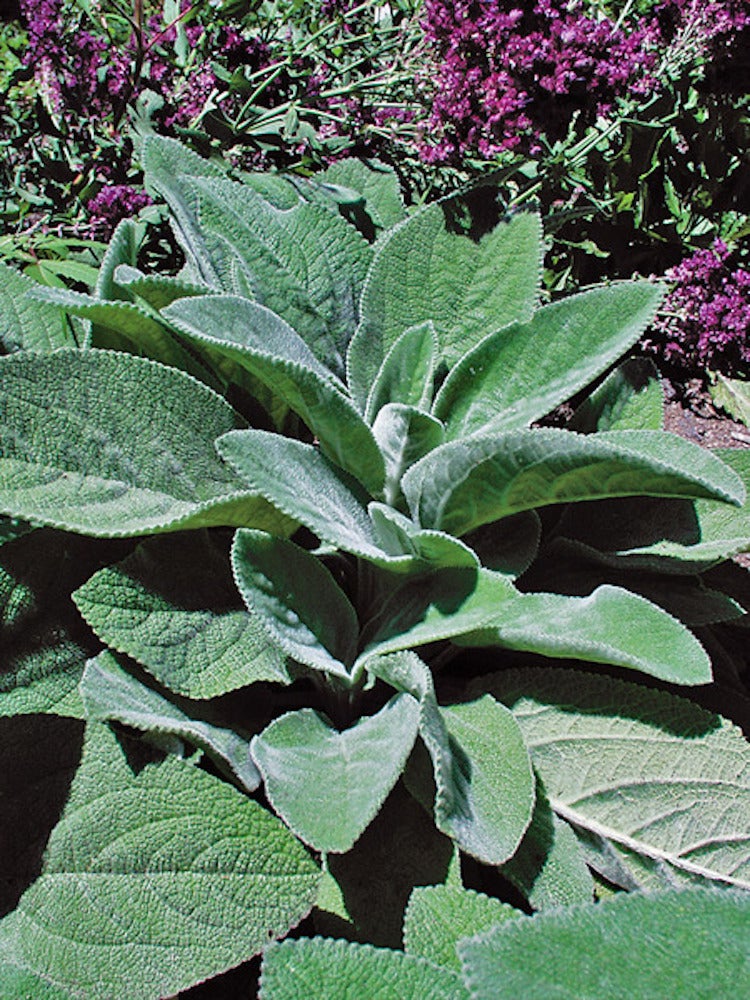
Unlike other varieties of lamb’s ear that self-sow, Helen von Stein (aka Big Ears) rarely flowers. Silvery soft tufts thrive in dry, full sun locations. Although lamb’s ear will tolerate Zones 4 through 9, it suffers in areas prone to humid summers. And though it will remain evergreen in warm climates, its leaves degrade in colder regions. Available from Bluestone Perennials
.
Betony ‘Hummelo’

Bundles of glossy green leaves form in spring, developing purple flowering spikes in early summer. Deadhead these early blooms to ensure a second flush of flowers in late summer and early fall. The plant thrives in Zones 4 through 8 and is evergreen in warmer climates. Over time, Hummelo will naturalize and form a dense mat. Available on Amazon
.
Royal Purple Smoke Bush

A purplish-pink haze covers the top of this deciduous shrub in summer, giving smoke bush, or smoke tree, its name. The “smoke” remains into fall and complements the dark maroon foliage. For best results, site the shrub in well-draining soil in full sun in Zones 5 through 8. Available from The Home Depot
.
Bloody Cranesbill
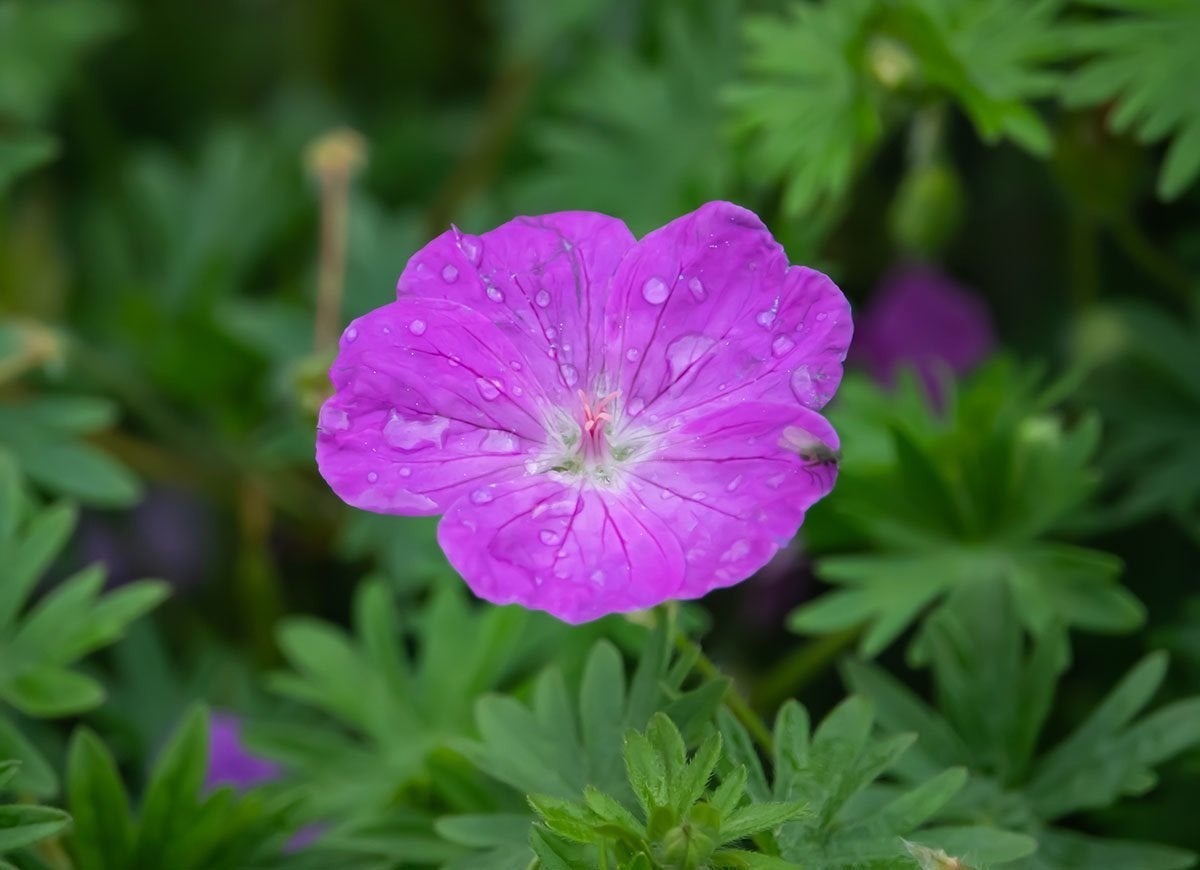
This clump-forming perennial is covered in magenta flowers in May and June, and reblooms sporadically throughout summer. Bloody Cranesbill does best in full or partial sun in Zones 3 through 8 and holds up well in hot summers and cold winters. At the first frost, the plant will respond by putting forth foliage in shades of reds and oranges. Available from Etsy
.
Hellebore

One of the easiest perennials to grow, hellebore prefers a moist, well-shaded site in Zones 4 through 9, but it will tolerate dry and shaded conditions. Saucer-shaped flowers in white, pink, deep reds, and yellow remain in bloom for months, and the deer-resistant foliage is evergreen throughout most of the winter. Available from The Home Depot
.
Summersweet ‘Vanilla Spice’

Vanilla Spice is a compact deciduous shrub that prefers partial sun but will tolerate full sun if it receives adequate moisture. The glossy green foliage is deer resistant, and summersweet’s huge fragrant flowers are attractive to pollinators. Thriving in Zones 4 through 8, it is one of only a few shrubs that will flower in shady sites in late summer. The plant persists with lovely golden color in fall and interesting seed capsules in winter. Available from Etsy
.
Asters

Just when most flowers are starting to fade, asters pop up in vibrant hues, which is just one reason why it’s an excellent fall plant. In addition to its bright coloring, asters take little effort to maintain. Plant it in loamy, well-drained soil and make sure it receives good sunlight. If you live in zones 3 to 8, this plant is a no-brainer for your fall garden. Available from The Home Depot.
Chrysanthemums

It’s not an autumn landscape without chrysanthemums. This hardy fall plant is available in a spectrum of colors, from bright white to deep burgundy. For potted mums, provide the plant with a large container and place it in a sunny spot. If you live in zones 5 through 9 you can plant perennial chrysanthemums in your garden. These plants can tolerate even the winter, just be sure to surround it with mulch to keep its shallow roots warm. Available from The Home Depot.
Coneflower

This native plant is a hassle-free addition to any landscape. Ideal for zones 4 through 8, the coneflower is a fast-growing, drought-tolerating plant that blooms through fall. It’s cone-like center (hence the name) attracts birds, bees, and butterflies while its prickly stem deters deer. While the coneflower will do fine in partial shade and poor soil, it will really thrive in full sun and well-drained soil. Available from The Home Depot.
Kaleidoscope Abelia

Like its name implies, kaleidoscope abelia is an ever-changing display of color throughout the year. From spring to summer expect golden yellow foliage that transitions to red-orange in the fall and winter. It also blooms delicate white flowers from mid-summer through fall. You can expect kaleidoscope abelia to grow up to 30-inches and 4-feet wide. Find it in a spot where it can get full to partial sun and water it regularly. This fall plant is best for zones 6 through 9. Available from The Home Depot.
Fall Flowers

A beautiful landscape doesn’t have to die when summer ends. Choose these fall plants that require minimal effort and look great.

All You Need to Care for Your Lawn & Garden
Keeping your grass green and your plants thriving doesn’t just take a green thumb—it starts with the right tools and supplies.